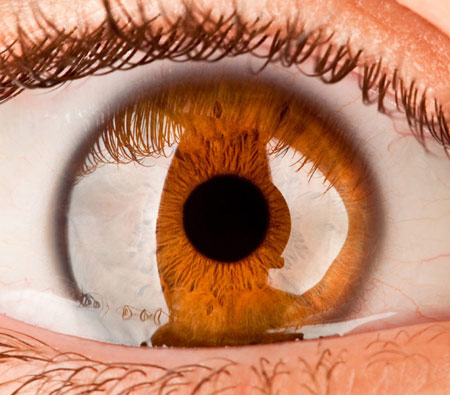Artificial cornea was born
International scientists have found a way to create artificial corneas, an invention that can light millions of people around the world and reduce the need for donated corneas.

Artificial cornea in the eyes of a patient participating in the trial. (Photo: Discovery).
The human cornea is a thin transparent membrane, covering the iris and pupil of the eye. If the cornea is damaged, vision may decrease or even humans may be completely blind.
Discovery News said Swedish, Canadian and American scientists have found a way to create corneas from artificial collagen fibers. Collagen is a protein that accounts for up to 25% of the total protein in the human body, with the main function of connecting body tissues together. Scientists often liken collagen to a glue that binds parts of the human body into a complete block, without which the human body would be only discrete parts.
The demand for corneas is very high because the number of people needing is always greater than the number of donors. So using artificial collagen will help reduce the need for donated corneas.
The research team conducted artificial corneal test on 10 people with pyramid corneal disease or central corneal scar. This is a disease that causes the cornea to thin out and make the eye gradually look like a cone. People with this disease are sensitive to light and images multiply many times. In most cases, contact lenses help patients with normal corneal corneas. But with more severe cases, patients need to re-implant the entire cornea.
When implanted, the replacement cornea stimulates damaged cells to restore and produce new tissue. " An artificial cornea can adapt and stimulate eye recovery ," said May Griffith, a doctor at the Research Institute of Ottawa, Canada Hospital.
The new method helps the recipient's cells adapt to the artificial cornea. Patients will avoid the risk of infection and feel better. In addition, Professor Shukti Chakravarti of the Johns Hopkins Institute of Medicine in the US added: 'Once those cells recover, they can also contribute to protecting the cornea .'
After two years healthy cells developed, completely covering the artificial cornea in the eyes of 9 of 10 patients. The new cornea also creates tears and reacts when stimulated. Visual acuity in 6 out of 10 patients has been improved in comparison with patients with real corneal transplants.
' This new method can help bring light to millions of people, ' Griffith said.
Currently, artificial corneas are only effective in patients with severe pyramidal corneas.
" We are planning to carry out further studies to expand the application of artificial biological corneas with other eye diseases, " said Dr. Per Fagerholm in Sweden.
The study is published in the journal Science Translational Medicine.
- Artificial corneal like real
- Use artificial cornea to restore vision
- 3D printing gets both corneas and implants successfully, people really come to the future
- See artificial ear from human ribs
- Rhino was born with the first artificial insemination method in the United States
- Prevention of corneal ulcer disease
- Artificial insemination - the reverse side of the miracle
- Species of parasites
- Artificial intelligence can predict when you die
- Presbyopia eye recovery technology with new technology
- Detecting the 6th layer in the human eye
- America welcomes the first baby born from a mother who has a uterine transplant
 Green tea cleans teeth better than mouthwash?
Green tea cleans teeth better than mouthwash? Death kiss: This is why you should not let anyone kiss your baby's lips
Death kiss: This is why you should not let anyone kiss your baby's lips What is salmonellosis?
What is salmonellosis? Caution should be exercised when using aloe vera through eating and drinking
Caution should be exercised when using aloe vera through eating and drinking